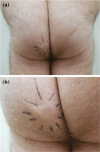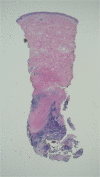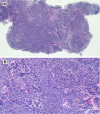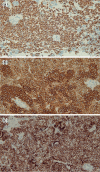Merkel Cell Carcinoma with a Suppressor of Fused (SUFU) Mutation: Case Report and Potential Therapeutic Implications
- PMID: 25876211
- PMCID: PMC4470960
- DOI: 10.1007/s13555-015-0074-5
Merkel Cell Carcinoma with a Suppressor of Fused (SUFU) Mutation: Case Report and Potential Therapeutic Implications
Abstract
Introduction: Merkel cell carcinoma is a neuroendocrine malignancy. Suppressor of fused (SUFU) is a tumor suppressor oncogene that participates in the Hedgehog (Hh) signaling pathway. The aim of the study was to describe a patient whose Merkel cell carcinoma demonstrated a SUFU genomic alteration.
Case study: The Hh signaling pathway is involved in the pathogenesis of several tumors, including nevoid basal cell carcinoma syndrome that is associated with an alteration of the patched-1 (PTCH1) gene. Targeted molecular therapy against smoothened (SMO) with vismodegib has been shown to be an effective therapeutic intervention for patients with PTCH-1 mutation. The reported patient was presented with metastatic Merkel cell carcinoma. Analysis of his tumor, using a next-generation sequencing-based assay, demonstrated a genomic aberration of SUFU protein, a component of the Hh signaling pathway that acts downstream to SMO and, therefore, is unlikely to be responsive to vismodegib. Of interest, arsenic trioxide or bromo and extra C-terminal inhibitors impact signals downstream to SUFU, making this aberration conceivably druggable. His tumor has initially been managed with chemotherapy (carboplatin and etoposide) and subsequent radiation therapy is planned.
Conclusion: The pathogenesis of Merkel cell carcinoma is multifactorial, and related to ultraviolet radiation exposure, immunosuppression, and Merkel cell polyomavirus. We report a patient with a mutation in SUFU, a potentially actionable component of the Hh signaling pathway.
Figures





Similar articles
-
The relevance of a suppressor of fused (SUFU) mutation in the diagnosis and treatment of Gorlin syndrome.JAAD Case Rep. 2018 Feb 2;4(2):196-199. doi: 10.1016/j.jdcr.2017.10.011. eCollection 2018 Mar. JAAD Case Rep. 2018. PMID: 29892665 Free PMC article. No abstract available.
-
The role of the Hedgehog signaling pathway in cancer: A comprehensive review.Bosn J Basic Med Sci. 2018 Feb 20;18(1):8-20. doi: 10.17305/bjbms.2018.2756. Bosn J Basic Med Sci. 2018. PMID: 29274272 Free PMC article. Review.
-
Regulation of Sufu activity by p66β and Mycbp provides new insight into vertebrate Hedgehog signaling.Genes Dev. 2014 Nov 15;28(22):2547-63. doi: 10.1101/gad.249425.114. Genes Dev. 2014. PMID: 25403183 Free PMC article.
-
Genomic testing, tumor microenvironment and targeted therapy of Hedgehog-related human cancers.Clin Sci (Lond). 2019 Apr 29;133(8):953-970. doi: 10.1042/CS20180845. Print 2019 Apr 30. Clin Sci (Lond). 2019. PMID: 31036756 Review.
-
Patched Homolog 1 (PTCH1) Mutation in a CIC-Rearranged Sarcoma: Lack of Response to the Smoothened (SMO) Vismodegib.Cureus. 2023 Jan 27;15(1):e34281. doi: 10.7759/cureus.34281. eCollection 2023 Jan. Cureus. 2023. PMID: 36843760 Free PMC article.
Cited by
-
SUFU promotes GLI activity in a Hedgehog-independent manner in pancreatic cancer.Biochem J. 2023 Aug 16;480(15):1199-1216. doi: 10.1042/BCJ20220439. Biochem J. 2023. PMID: 37477952 Free PMC article.
-
Genomic portfolio of Merkel cell carcinoma as determined by comprehensive genomic profiling: implications for targeted therapeutics.Oncotarget. 2016 Apr 26;7(17):23454-67. doi: 10.18632/oncotarget.8032. Oncotarget. 2016. PMID: 26981779 Free PMC article.
-
Hedgehog/GLI Signaling Pathway: Transduction, Regulation, and Implications for Disease.Cancers (Basel). 2021 Jul 7;13(14):3410. doi: 10.3390/cancers13143410. Cancers (Basel). 2021. PMID: 34298625 Free PMC article. Review.
-
Clinical and molecular characterization of virus-positive and virus-negative Merkel cell carcinoma.Genome Med. 2020 Mar 18;12(1):30. doi: 10.1186/s13073-020-00727-4. Genome Med. 2020. PMID: 32188490 Free PMC article.
-
Merkel Cell Polyomavirus Exhibits Dominant Control of the Tumor Genome and Transcriptome in Virus-Associated Merkel Cell Carcinoma.mBio. 2017 Jan 3;8(1):e02079-16. doi: 10.1128/mBio.02079-16. mBio. 2017. PMID: 28049147 Free PMC article.
References
-
- Foundation Medicine, Inc., Cambridge. http://www.foundationmedicine.com. Accessed Mar 25, 2015.
-
- Frampton GM, Fichtenholtz A, Otto GA, Wang K, Downing SR, He J, Schnall-Levin M, White J, Sanford EM, An P, Sun J, Juhn F, Brennan K, Iwanik K, MAillet A, Buell J, White E, Zhao M, Balasubramanian S, Terzic S, Richards T, Banning V, Garcia L, Mahoney K, Zwirko Z, Donahue A, Beltran H, Mosquera JM, Rubin MA, Dogan S, Hedvat CV, Berger MF, Pusztai L, Lechner M, Boshoff C, Jarosz M, Vietz C, Parker A, Miller VA, Ross JS, Curran J, Cronin MT, Stephens PJ, Lipson D, Yelensky R. Development and validation of a clinical cancer genomic profiling test based on massively parallel DNA sequencing. Nat Biotechnol. 2013;31:1023–1031. (PMID = 24142049). - PMC - PubMed
LinkOut - more resources
Full Text Sources
Other Literature Sources
Miscellaneous

